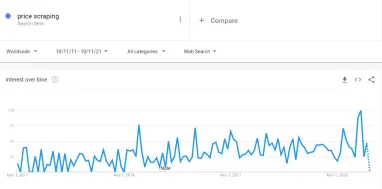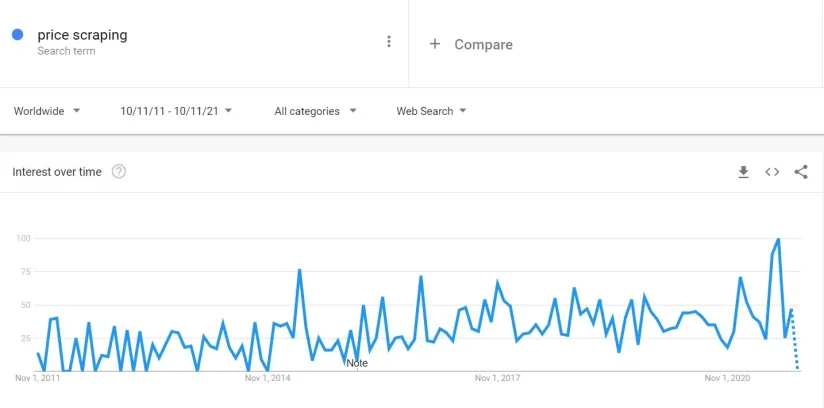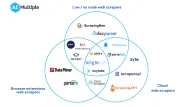Guide To Price Scraping: Best Tools & Legal Issues in 2024


Price scraping is extracting competitors’ price data from online resources via web scrapers with or without obtaining permission to do so. Businesses that utilize dynamic pricing models, such as travel, retail, and e-commerce business owners, use price scraping to adjust their prices and attract their competitors’ customers.
However, some e-commerce and travel websites set up barriers to disable web scraping in order to avoid potential harm to their businesses. This article explores price scraping and how it can elevate your pricing strategy.
Price scraping tools
Price scraping can be done manually where users access websites and extract the data they need manually, however, this is time and resource consuming. Therefore, businesses can scrape prices via:
Web scraping bots
Web scraping bots, also known as web scrapers, are a type of software that can automate the targeting and extraction of data from online resources. The bot will download the website’s robot.txt file which contains the list of URLs for the bot to crawl, access the URLS and pull their data, and input it to spreadsheets.
Web scraping APIs
Web scraping APIs allow users to access and collect public data from websites. To use web scraping APIs, you need to have knowledge of a programming language such as Python or JavaScript. For instance, you need to make HTTP requests to the API endpoints and parse the data returned by the API.
RPA bots
RPA bots leverage screen scraping to replicate human interactions with GUI elements. RPA bots can be programmed to access targeted URLs, scroll through the pages, identify pricing data, and copy and paste it into spreadsheets and databases. RPA bots can also perform different operations on the extracted data, such as sending it to certain users, comparing it to different databases, modifying it based on set rules, etc.
In-house price scraping scripts
Businesses that have skilled programming teams can choose to create a price scraper from scratch instead of investing in an off-the-shelf solution. In-house web scrapers provide more customization capabilities, however, they typically come with higher costs associated with servers, proxies, and talent acquisition.
Businesses that don’t have the capacity to program and maintain a web scraping or RPA bot can leverage bot-as-a-service (BaaS) or RPA-as-a-service (RPAaaS) to outsource their scraping activities.
Top price scraping tools
| Vendors | Pricing/mo | Trial | PAYG | Type |
|---|---|---|---|---|
| Bright Data | $500 | 7-day | ✅ | No-code |
| Smartproxy | $50 | 3K free requests | ❌ | No-code |
| Oxylabs | $49 | 7-day | ❌ | API |
| Nimble | $600 | 7-day | ❌ | API |
| SOAX | $59 | 7-day | ❌ | API |
| Zyte | $100 | $5 free for a month | ❌ | API |
| Diffbot | $299 | 14-day | ❌ | API |
| Octoparse | $89 | 14-day | ❌ | No-code |
| Nanonets | $499 | N/A | ✅ | OCR API |
| Scraper API | $149 | 7-day | ❌ | API |
Is price scraping legal?
Price scraping faces the same legal issues of web scraping in general, such that it is not an illegal act itself, but depends on the use of the extracted data. For example, in the case of eBay vs. Bidder, where Bidder crawled eBay’s pricing data for competitive pricing purposes, the judge did not consider their actions as breaking the federal hacking rules.
However, in other cases, judges ruled against the data crawlers. For instance, in the case of American Airlines (AA) vs FareChase where FareChase was selling software to automate the tracking and extraction of online pricing data, American Airlines were able to obtain an injunction from a Texas trial court, stopping FareChase from accessing AA’s website, updating their software based on AA’s data, or selling software that enables users to compare online fares if the software also searches AA’s website.
Therefore, although prices are public data and scraping them does not violate any hacking rules, the lawfulness of price scraping depends on the website’s terms and conditions agreement which either allows or denies web scraping of its public data.
How does price scraping work?
Price scraping can be done using multiple tools, such as web scraping or RPA bots, and it is typically done in 2 steps:
- Targeting competitor website: The bot is programmed to require access to target website at certain time intervals (every minute, hour, etc.), track the activity of the websites, and observe pricing data changes.
- Extracting the data: Once the bot gains access to the website, it will pull relevant data from the website and input it to spreadsheets or databases for further analysis.
What are the benefits of price scraping?
Price scraping enables:
- Customer behavior analysis: Price scraping enables businesses to understand customers’ purchase behavior and the prices they are willing to pay for certain products at certain times. This helps businesses optimize their pricing strategies according to the current market requirements.
- Competitor analysis: Price scraping helps businesses analyze their competitors’ pricing techniques, and adjust their own accordingly. For instance, businesses can understand that their competitors use static pricing techniques for certain products, while implementing different types of dynamic pricing for others.
You can also check our guide to finding the right competitive intelligence tools for your business.
What are the challenges of price scraping?
Although price scraping is not illegal, some businesses believe that it puts them at a competitive disadvantage, as well as slows down customer access to websites, and decreases conversion rates. Therefore, marketplace websites tend to create barriers to limit the scraping of their websites. These barriers are the same that are set against typical web crawler, and they include:
However, some of these barriers may reduce brands’ exposure, and harm the business more than competitive pricing techniques. For instance, Google recently announced that their crawler cannot bypass CAPTCHAs and therefore, cannot rank the content hidden behind them. Nonetheless, businesses can provide Googlebot with a CAPTCHA-free version of the page, different from the version regular users are served. This enables Googlebot to rank their content while still maintaining the capabilities of their CAPTCHA on their content.
Read our in-depth guide on web scraping best practices to explore how to tackle web scraping challenges in more detail.
For more on web scraping
To understand how different businesses and departments use web scraping, feel free to read our in-depth articles about web scraping:
To explore use cases of web scraping, check out our data-driven list of the top 18 use cases and applications of web scrapers and web crawlers.
And if you believe your business will benefit from web scraping, feel free to scroll through our data-driven list of web scraping tools
And let us guide you through the process:

Cem has been the principal analyst at AIMultiple since 2017. AIMultiple informs hundreds of thousands of businesses (as per similarWeb) including 60% of Fortune 500 every month.
Cem's work has been cited by leading global publications including Business Insider, Forbes, Washington Post, global firms like Deloitte, HPE, NGOs like World Economic Forum and supranational organizations like European Commission. You can see more reputable companies and media that referenced AIMultiple.
Throughout his career, Cem served as a tech consultant, tech buyer and tech entrepreneur. He advised businesses on their enterprise software, automation, cloud, AI / ML and other technology related decisions at McKinsey & Company and Altman Solon for more than a decade. He also published a McKinsey report on digitalization.
He led technology strategy and procurement of a telco while reporting to the CEO. He has also led commercial growth of deep tech company Hypatos that reached a 7 digit annual recurring revenue and a 9 digit valuation from 0 within 2 years. Cem's work in Hypatos was covered by leading technology publications like TechCrunch and Business Insider.
Cem regularly speaks at international technology conferences. He graduated from Bogazici University as a computer engineer and holds an MBA from Columbia Business School.
To stay up-to-date on B2B tech & accelerate your enterprise:
Follow on

Comments
Your email address will not be published. All fields are required.